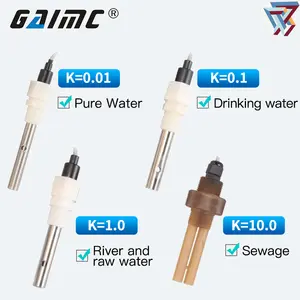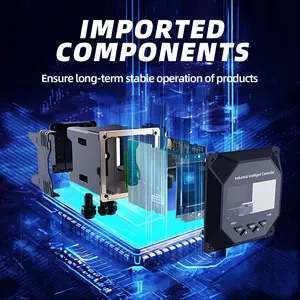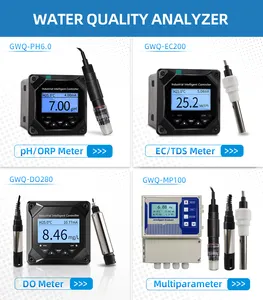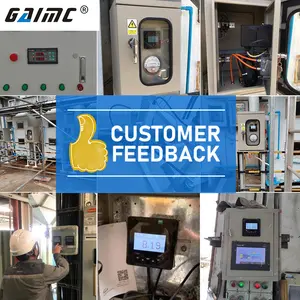(2014 products available)








































































































































































































A TDS control system helps monitor the total dissolved solids in water so they can be filtered out by reverse osmosis. TDS stands for total dissolved solids, which are measured in parts per million (ppm) or milligrams per liter (mg/L). Individuals may see an increase or decrease in water quality due to a TDS meter, but the TDS level does not directly represent water quality because different substances affect water quality.
There are mainly two types of TDS systems:
Though TDS control systems differ in functionalities, they all aim to maintain water quality by regulating the TDS (total dissolved solids) levels.
Water Purification and Treatment
A TDS control system helps in water purification by separating impurities from water. These impurities can include salts, metals, minerals, and stones which are harmful to human health. This system uses a multi-stage purification process which may include activated carbon filters, UF membrane, crucial minerals filters, or Nano filters. The process always depends on the existing water quality and specific requirements. Through effective removal of impurities, a TDS control system provides clean and safe drinking water. This helps to prevent various water related diseases and improves water quality.
Regulating TDS Levels
A TDS control system works by regulating total dissolved solids in water which is important for water quality management. It does this by removing salts, minerals, and metals from the water or adding them in controlled amounts so that people can drink with good health standards. The process always depends on the existing water quality and specific requirements. Through effective removal of impurities, a TDS control system provides clean and safe drinking water.
By maintaining the TDS within the specified limits, the system helps to improve the overall quality of water. This way, it can also enhance drinking and other domestic uses.
Minral Retention
Mineral retention is an essential feature of TDS control systems. After removing dissolved solid from water through filtration, some vital minerals like calcium, potassium, or magnesium can be retained. These minerals are very important for human health and well-being. A TDS regulator helps to strike a balance between proper mineral retention and harmful mineral retention in water. It does this by using advanced filtration technologies. Retaining these vital minerals in water help to improve sensorial properties such as taste.
Automated Monitoring and Control
The automated monitoring and control feature of TDS control systems works by continuously checking the TDS levels in water. It also ensures that the TDS levels are in set limits. This feature helps to provide real time measurements of TDS concentration. With this, people can make informed decisions concerning water quality. Automated monitoring and control can also alert people when the TDS levels go beyond the specified limits. This ensures quick response to any changes in water quality. Control systems can also adjust its operation parameters automatically to maintain the desired water quality.
Their precise control and measurement of dissolved solids make TDS control systems essential in many industries. They have applications in water treatment facilities, where they aid in overseeing the quality of produced water. By continually monitoring and adjusting the levels of dissolved solids in the water, these systems help ensure that the TDS remains within acceptable limits and that the treated water meets all necessary standards. Similarly, in industrial processes such as chemical manufacturing or mining operations, a TDS control system plays a crucial role in managing solution concentrations and preventing excessive scaling or corrosion issues. In aquaculture systems, these controllers help maintain proper water quality conditions for optimal fish breeding and keeping. Moreover, in commercial hydroponic farming setups, a TDS control system is vital for managing nutrient solution concentrations essential for plant growth.
Specific examples of industries that utilize TDS control systems and their functions include:
These are just some examples of industries where TDS control systems find applications. Their importance lies in maintaining water quality standards, preventing damage to equipment, ensuring compliance with regulations, and safeguarding human health and the environment.
When looking for a suitable TDS control system for sale, buyers need to understand what different values of TDS imply regarding water quality. They should know that specific TDS levels indicate a need for further testing to identify the source of the impurities and that high TDS levels can pose health risks. Buyers should also be informed about what TDS control systems can and cannot do.
When purchasing TDS control systems for customers, buyers need to get systems suited to their customers' needs. Here are some more tips to help purchasers of TDS control systems:
Q: What is a TDS control system?
A: It is a control system designed to measure the total dissolved solids in water and manage the level of TDS to ensure safe and good-quality water.
Q: What is the purpose of a TDS control system?
A: The TDS control system aims to manage the levels of TDS in water because high or low TDS levels can affect its taste and quality. Regulating TDS levels helps provide users with safe drinking water.
Q: How does a TDS control system work?
A: A TDS control system works by measuring the amount of total dissolved solids (TDS) in the water through a TDS meter. If the TDS level is too high, the system may use processes like reverse osmosis to purify the water by removing the solids for Better water quality.
Q: What is TDS control?
A: TDS control is the regulation or management of total dissolved solids in the water to provide safe levels for drinking.
Q: Why is TDS control important?
A: TDS control is important because it helps ensure good quality water for drinking or food purposes. Maintaining TDS levels helps provide water with better taste and prevents any adverse effects on health.